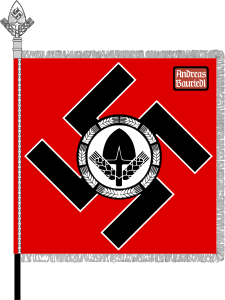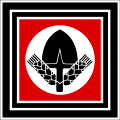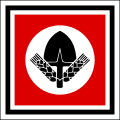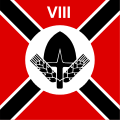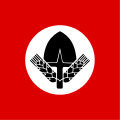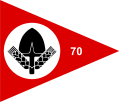Flags of the Reich Labor Service
The flags of the Reich Labor Service (1933-1945) were the flags and pennants used by the Labor Service (RAD) during the Nazi era .
Voluntary Labor Service (FAD) flags
The forerunner of the RAD was founded as a voluntary labor service as early as 1931 . The flags used by this organization already showed the future symbols of the RAD, albeit in a slightly modified form, whereby the exact period of use is not known. Swastikas in flags were probably not in use until 1933. For example, the male division displayed a red flag with a stylized spade surrounded by two ears of wheat in a white circular area. The female faction used a red flag with a circular disc outlined in black and offset to the left. In this there was a swastika surrounded by three ears of corn on each side.
Flags from 1933
When the Reich Labor Service was founded in 1933, the symbolism of the FAD was adopted. Thus the leaf of the spade was brought into a round shape, while the appearance and number of ears of corn were unified in men and women. These regulations took place in November 1933.
Flags from 1934
On March 1, 1934, the flags were expanded and finally set. At this time, the first car flags and pennants were introduced.
Flags
Flags were awarded to each of the various departments of the RAD, all of which had been produced according to a uniform pattern. The dimensions of the flags and the attachment of the cloth to the flagpole with the help of nails - this is only common in the Wehrmacht - showed the close connection that the RAD was to be assigned to military units. The flagpole ended in a nickel-plated representation of the RAD symbol "Spades and ears". The square flag had a side length of 125 cm, was made of pure silk, and carried a black swastika on its tip along its entire length. The symbol of the male section of the RAD, a spade and two ears of wheat, surrounded by a wreath of ears of wheat, was placed on top of this. The flag was surrounded on three sides by fringes made of silver-colored aluminum braid, which were 45 mm long. In the upper right corner of the cloth was usually the department number in white Arabic numerals. This position was only common for RAD flags; flags of other Nazi organizations had such designations next to the flagpole. A special title could be assigned to a department as a special honor. In this case, instead of the department number, the honorary title was shown in a flag mirror, which was applied to an earth-brown background in white, Gothic script. The flag mirror was surrounded by a narrow, black braid. As a further special award of a department, it was customary to give it the opportunity to attach this ribbon to the flag by awarding it a flag banderole.
Department flag of the RAD
(here with the honorary title " Andreas Bauriedl ")
Motor vehicle flags
The square standards on vehicles had a side length of 25 cm. The pennants had a size of 30 × 35 cm or 25 × 30 cm for department leaders, departments, leaders of the Reichslehrlager and the Reichslehrlager. The general RAD pennant had the dimensions 15 × 26 cm. All stands or pennants were placed on the left fender. The standard of the Reich Labor Leader Konstantin Hierl , introduced on March 1, 1934 , was changed for the first time on August 22, 1934. An official regulation for this change has not yet been found.
1 = Reichsarbeitsführer 1934, size of the red square 17 × 17 cm, white disc 14.5 cm in diameter with RAD symbol. White-black-white-black-white banding in the dimensions 0.5-1.5-0.5-1.0-0.5 cm from outside to inside.
2 = Reichsleitung des Arbeitsdienst, size of the red square 19 × 19 cm, white disk 14.5 cm in diameter with RAD symbol, the white-black-white stripes each 1 cm wide.
3 = Reichsarbeitsführer 1934–1937, dimensions and borders as standard of the Reichsleitung. Size of the swastika 12.5 × 12.5 cm with 1.5 cm bar thickness, outlined in silver. In the center, the symbol of the RAD with a silver-colored wreath of ears is attached.
4 = Gauarbeitsführer, under the RAD symbol, four diagonal, 42 mm wide bands, white-black-white in the size 0.6 × 3.0 × 0.6 cm. In the upper part, the agency number in Roman numerals.
5 = inspector of driving schools and inspector of teaching departments. As Gauarbeitsführer, but without agency number
6 = Arbeitsgauleitungen. Like Gauarbeitsführer, but without ribbons.
7 = staff of the inspectors. Like the inspector of the driving schools, but without ribbons
8 = group leader. On the thighs a 22 mm wide border with two 7 mm wide black stripes. At the flying end the group number in Arabic numerals.
9 = Reich School of the RAD.
10 = group leader. In the right part the group number in Arabic numerals.
11 = Head of the District Leader Schools. Like group leader, but the department name BS instead of the group number .
12 = District driving schools of the RAD. Like Reichsschule, but with the inscription BS .
13 = head of department. A total of 18 mm wide white stripe on the thighs. In the middle a 6 mm wide black stripe. In the right part the department number in Arabic numerals.
14 = departments. Like department head, but without stripes.
15 = leader of the Reichslehrlager. Like department head, but with the inscription LV .
16 = Reich teaching camp. Like leaders of the Reichslehrlager, but without stripes.
17 = General RAD pennant for service vehicles and bicycles.
Flags from 1937
After the RAD had already been made a Supreme Reich Authority by a party organization in 1935 , the power apparatus was restructured in 1937. Due to an order dated September 2, 1937, on the one hand, some flags were changed and, on the other hand, motor vehicle pennants were introduced for the first time for managers of young women. The attachment of stands and pennants has again been fixed on the left side of the vehicle. An extension of the use of the stand for the inspectors, labor leaders and heads of office (2) was introduced in October 1937 by allowing all representatives of the named groups of people to attach the stand to the vehicle.
1 = Reich Labor Leader 1937–1945. Standard 30 × 30 cm, surrounded by a white-black-white border, each 10 mm wide. In the center there is a swastika on top, bordered in black and white. Ear wreath with 80 mm diameter. In the four corners of the flag the emblem of the empire.
2 = inspectors, labor leaders and heads of office at the Reich leadership. Size of the stand 20 × 30 cm, with narrow white-black-white-black-white ribbons on the edge
3 = work pipes , group staff and schools, 20 × 30 cm, brown cloth. In the right part the dormer mark in Roman numerals. The same pennant for group sticks showed the designation in Arabic numerals, while the one for the Reichsschule bore the inscription RS .
4 = Leader of the labor service for young women from the rank of camp leader upwards.
Flags from 1938
In 1938 a last new pennant was introduced, during which the national emblem was added to the RAD leader.
In 1940 it was decided that the standard of the Reichsarbeitsführer should now be affixed to the right side of the vehicle. The name of the leaders among the female youth was changed to Maidenoberführerin .
1 = Leader of the labor service for female youth ( Maidenoberführer from 1940) from the rank of camp leader upwards or a leader belonging to the RAD office for female youth from the rank of field master upwards.
2 = district leaders.
literature
- Davis / McGregor: Flags of the Third Reich , Part 3, London 1994, ISBN 1 85532 459 8
- Andreas Herzfeld: The Rimann Collection of German Car Flags and Vehicle Stands , Volume 1, Berlin 2013, ISBN 978-3-935131-08-7
Individual evidence
- ↑ Orders D 3404/33 and V2 6043/33 VBl No. 9 (1933)
- ↑ Available V2.I 646/34 or V2.II 3612/34, special edition
- ^ Law for the Reich Labor Service, RGBl. 1935 I, pp. 769-771
- ↑ RMBlipV 1937, p. 1491
- ↑ VBl RAD 845/1937
- ↑ Flag flying on company cars of RAD v. July 14, 1938, RMBliV 1938, p. 1221
- ^ Flags on RAD official vehicles from November 16, 1940, RMBliV 1940, p. 2143






